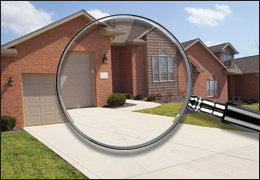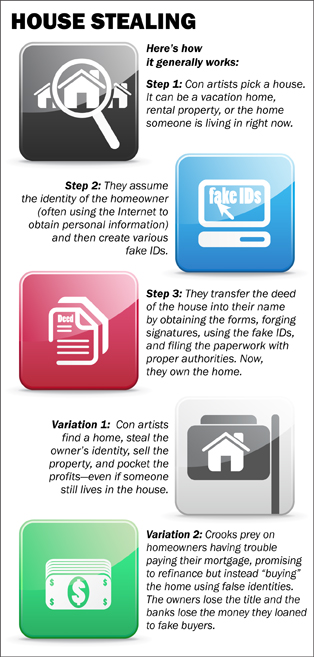|
What do you get when you combine two popular rackets these days—identity theft and mortgage fraud? A totally new kind of crime: house stealing.
Here’s how it generally works:
… The con artists start by picking out a house to steal—say, YOURS.
… Next, they assume your identity—getting a hold of your name and personal information (easy enough to do off the Internet) and using that to create fake IDs, social security cards, etc.
… Then, they go to an office supply store and purchase forms that transfer property.
… After forging your signature and using the fake IDs, they file these deeds with the proper authorities, and lo and behold, your house is now THEIRS.*
There are some variations on this theme…
… Con artists look for a vacant house—say, a vacation home or rental property—and do a little research to find out who owns it. Then, they steal the owner’s identity, go through the same process of transferring the deed, put the empty house on the market, and pocket the profits.
… Or, the fraudsters steal a house a family is still living in…find a buyer (someone, say, who is satisfied with a few online photos)…and sell the house without the family even knowing. In fact, the rightful owners continue right on paying the mortgage for a house they no longer own.
It can get even more complicated than this, as we learned in a recent case out of Los Angeles that we investigated with the IRS. Last year, a real estate business owner in southeast Los Angeles pled guilty to leading a scam that defrauded more than 100 homeowners and lenders out of some $12 million. She promised to help struggling homeowners pay their mortgages by refinancing their loans. Instead, she and her partners in crime used stolen identities or “straw buyers” (people who are paid for the illegal use of their personal information) to purchase these homes. They then pocketed the money they borrowed but never made any mortgage payments. In the process, the true owners lost the title to their homes and the banks were out the money they had loaned to fake buyers.
So how can prevent your house from getting stolen? Not easily, we’re sorry to say. The best you can do at this point is to stay vigilant. A few suggestions:
- If you receive a payment book or information from a mortgage company that’s not yours, whether your name is on the envelope or not, don’t just throw it away. Open it, figure out what it says, and follow up with the company that sent it.
- From time to time, it’s also a good idea to check all information pertaining to your house through your county’s deeds office. If you see any paperwork you don’t recognize or any signature that is not yours, look into it.
House-stealing is not too common at this point, but we’re keeping an eye out for any major cases or developing trends. Please contact us or your local police if you think you’ve been victimized.
Resources:
- Los Angeles investigation press release
- Mortgage Fraud: General overview and statistics
- Related story
* - Since the paperwork is fraudulent, the house doesn't legally belong to the con artists.
Headline Archives home
|




